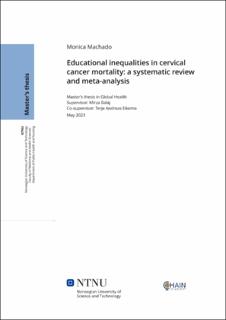| dc.description.abstract | Background: Evidence continues to affirm the educational inequalities in mortality, with individuals that have low educational attainment being most at risk. Education has been found to be a key determinant of adherence to preventive health measures such as cancer screening, due to its influence on people’s access to and awareness of such services. While the cancer burden continues to increase across the globe, cervical cancer stands as one of the most preventable forms, yet mortality rates are high with striking disparities between and within countries. There is a need for a comprehensive synthesis on the influence of level of education on cervical cancer mortality. This would serve as an evidence base for policy and intervention efforts seeking to close both the inequality and inequity gap, by identifying those most at risk. This study therefore aims to analyse the relationship between level of education and cervical cancer mortality, including an analysis of the variations across specific regions and sociodemographic characteristics, specifically age.
Methods: This study is a global systematic review and meta-analysis including available literature on the effect of educational attainment on cervical cancer mortality. A comprehensive literature search of 7 databases was completed and pooled studies without any language restrictions. Independent reviewers screened abstracts and full texts for eligibility based on inclusion and exclusion criteria, as well as mapped cervical cancer definitions. Inclusion in this review narrowed down to the presence of individual-level data on educational attainment and cervical cancer mortality, excluding survival analysis. Risk ratios (RR) and mortality rate ratios (MRR) were recalculated for studies reporting effect sizes in odds ratio (OR) for the meta-analysis, along with respective 95% confidence intervals. Educational categories were reclassified as low (ISCED 0-2), medium (ISCED 3-4) and high (ISCED 5-8). Random-effects meta-analyses using high education as the reference group were conducted to evaluate the overall effect of education on mortality, and stratified analyses were conducted to assess this effect by age group and region.
Results: Literature searches resulted in over 47,000 sources screened for inclusion. A total of
30 studies mentioned cervical cancer as a cause of death, and of these, 13 were included in this review. Individual-level data from 11 studies were included in the meta-analyses. Results from the meta-analyses showed an overall risk ratio of 2.41 (95% CI 1.81-3.20) for low education and 1.62 (95% CI 1.18-2.24) for medium education. In the stratified analysis, women with low education in both Northern and Southern Europe had a significant increase in the risk of cervical cancer mortality (RR 1.76, p ˂ 0.01 and RR 1.93, p < 0.01, respectively). However, only women with medium education in the South had a significant increase in the risk of mortality (RR 1.39, p < 0.04) compared to those in the North (RR 1.10, p=0.68). The impact of an additional level of education on reducing risk of cervical cancer mortality was greater among women in the North than the South. Regarding age, those aged 25-64 with low education had 5.73 times the risk of mortality (p ˂ 0.01), compared to those aged 25 and above, who had 2.11 times the risk (p< 0.01).
Conclusion: The results indicate that lower educational attainment is associated with an increase in the risk of cervical cancer mortality, with an additional level of education greatly reducing this risk, particularly in the sub-group analysis by region. There was no significant sub-group difference in risk between the regions considered. Conversely, the sub-group analysis by age suggested a significantly larger risk of cervical cancer mortality for younger cohorts with low education. This study provides the foundation for evidence-based policy that seeks to reduce health inequities and inequalities in both the health and education sector, to promote health and well-being for all.
Keywords: education, cause-specific, cervical cancer, inequality, mortality, health inequalities, inequity, educational attainment. | |
